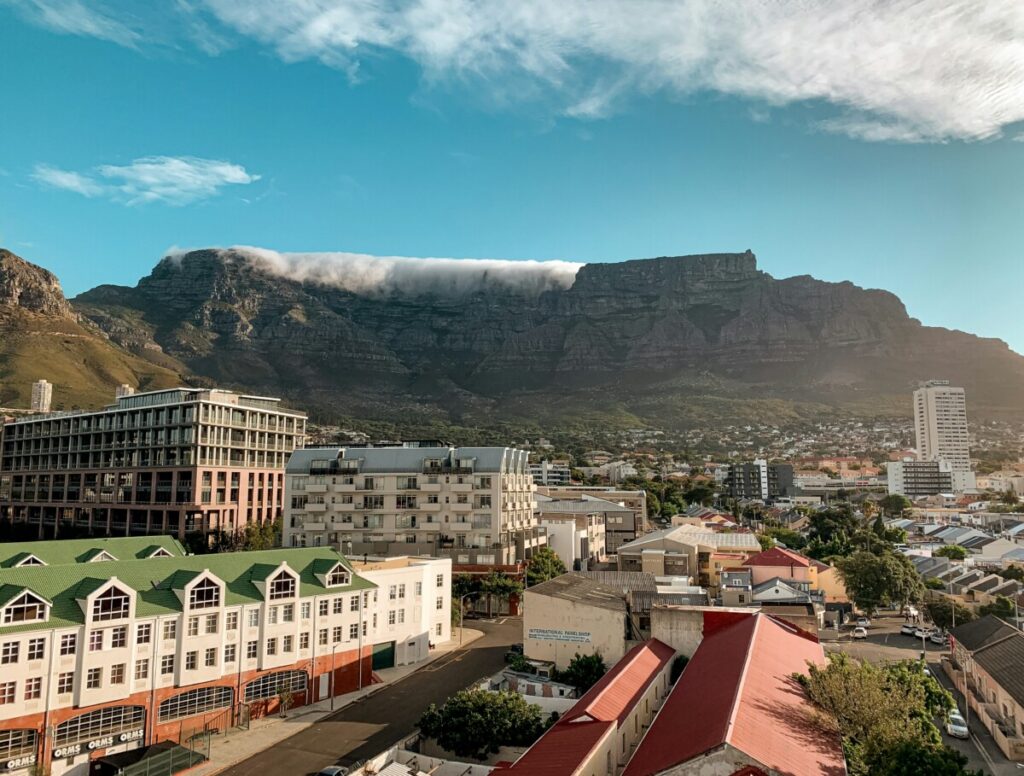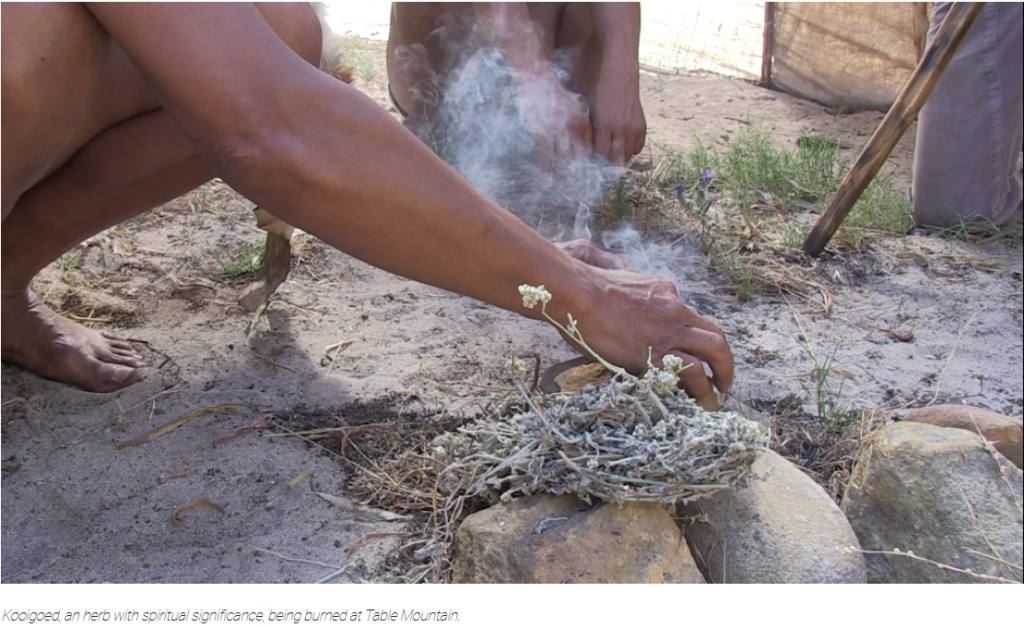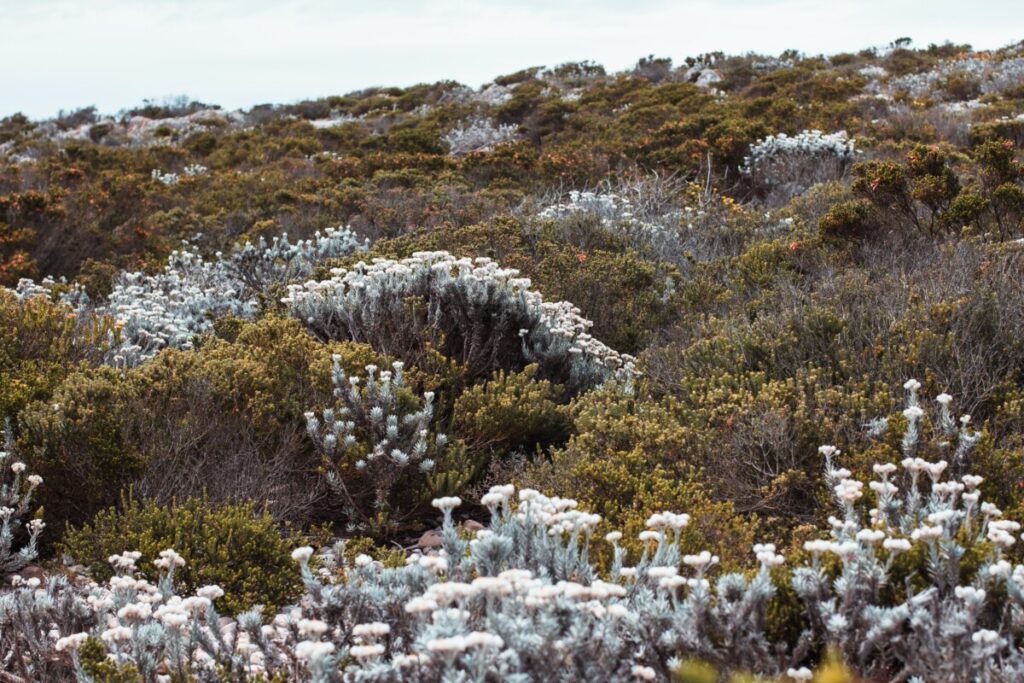by Sarah Orozco
People continually seek ways to recognize the cultural value of natural features. One way they do so is by producing lists like UNESCO World Heritage Sites, national parks, and New Seven Wonders of Nature, all of which include Table Mountain.

This article will describe how Table Mountain is a cultural landscape of the Cape Town, South Africa region; how this feature has shaped the development of the region, and how the people of this region have shaped the perception and physical attributes of this mountain.
The characteristic flat surface of the mountain has been geomorphologically formed by erosion of overlying sediments and large-scale tectonic activity. Geologically, the Table Mountain Group is primarily composed of sedimentary rocks. Sandstones produce its steep and jagged cliff faces. Debris flows and rockfalls are common below the cliff faces, potentially hazardous to human development. (Meadows, Compton)

Cape Town itself is a formal region, as a legal municipality and one of South Africa’s three capitals. Table Mountain helps form a functional region, defining the city bowl nestled between the mountains and the bay, with the rest of the large city spilling out all around it. The city bowl is the tourist center, the part of Cape Town that most commonly appears in pictures to represent the city.
This mountain has had significance for all the diverse people who have lived in the current Cape Town area. There is some evidence that it was inhabited over 30,000 years ago. The indigenous people of this region are the Khoi and San, who called it Hoerikwaggo or Mountain in the Sea. They believed their god Tsui or Goab lived in Hoerikwaggo, making it a scared place. (Table Mountain National Park)
The name “Table Mountain” originates from Antonio de Saldana’s 1503 name, Taboa de caba. This represents the late 15th century period of European exploration of the Western Cape. It was a significant landmark to navigators going around the southern tip of Africa, and what became Cape Town was the first European settlement in South Africa, giving it the moniker the “Mother City”. (Axelson)
While a mountain itself can do no wrong, it becomes intertwined with human history, triumphs and atrocities. In 1652, the Dutch violently colonized the Cape and established slavery in the region. Table Mountain, as a secluded place too dangerous for most habitation, became a place where enslaved people were sent to harvest firewood, and a place for some to escape and live as fugitives. (Van Sittert)
After the British took over, Table Mountain became more of a leisure site for the white middle and upper classes to admire the views and strengthen their romantic imperial attitudes. (Van Sittert) Over time, Table Mountain became an “icon for recreation” in South Africa. (Merwe)
Table Mountain is now a central part of tourism in Cape Town. People climb it, ascend via the cable car, or admire it from below. High levels of tourism contribute to cultural diversity in the area and then establish the vision of South Africa to the external eye.

It is also important to recognize who does not have access to the mountain, which likely includes most Cape Townians. In 2021 A group Khoi and San people known as the Mountain 12 were arrested for trespassing while engaging in sacred ceremonies on the mountain. They represent the movement to relearn and reclaim indigenous identity and culture after hundreds of years of colonialism and then Apartheid, which includes reclaiming their relationship with Table Mountain. (Ferris)
The natural features of a landscape often find their way into local culture and linguistics, together becoming the cultural landscape. In Cape Town, there are various descriptions of the “tablecloth” clouds that periodically cover the mountain. According to my grandmother’s story, this was the work of the mischievous Tokoloshe. The tablecloth is actually produced by southerly winds, which to colonizers were known as the “Cape Doctor” for keeping pollution low. (Axelson) Related mountain neighbors the Twelve Apostles and Lion’s Head reflect the culture (Christianity, significant animals) of this area.

While the geomorphic feature in question is the sandstone mountain itself, its biome is an equal part of the cultural landscape. Table Mountain is defined by its Fynbos flora, which is what defines its status as a UNESCO World Heritage site. (UNESCO) It’s likened to the Mediterranean, but Fynbos is truly unique, and a reflection of the mountain’s geology due to the soil development. (Meadows, Compton) There has been a push to conserve this ecology by limiting development on the mountain and encouraging native plant cultivation. This relationship between humans and biome can be described as cultural ecology. It is naturally fire-prone, but humans accelerated the fire cycle by planting and farming non-native trees which changes the mountain itself through ecology, runoff, and rockfall, and how people perceive it.
Table Mountain has also been a source of surface water from runoff and resulting springs. In the 19th century, it supplied most of the city’s water. This is a very significant contribution to that time when industrialization and British conquest was beginning. Dams were built to trap the flow. Now, it only accounts for 2% of Cape Town’s water. (WaterStories.co.za)
In 2016, Cape Town nearly ran out of water. As ‘Day Zero’ made international headlines, many residents and the government worked hard to conserve water, successfully avoiding the dreaded day. (source) Nowadays, Table Mountain is not a substantial part of Cape Town’s water supply, but it is important to understand the history to navigate contemporary water issues, which are likely to become more common around the world.
Sources
- Meadows, M., Compton, J. (2015). Table Mountain: Wonder of Nature at the Foot of Africa. World Geomorphological Landscapes, Springer International Publishing. DOI 10.1007/978-3-319-03560-4_11. https://www.researchgate.net/publication/301978085_Table_Mountain_Wonder_of_Nature_at_the_Foot_of_Africa
- (2023) Table Mountain History. Table Mountain National Park. https://tablemountainnationalpark.org/table-mountain-history/
- Axelson, E. (2023, November 15). Cape Town. Encyclopedia Britannica. https://www.britannica.com/place/Cape-Town
- Van Sittert, L. (2003). The bourgeois eye aloft: Table Mountain in the Anglo urban middle class imagination, c. 1891-1952. Kronos, 29, 161–190. http://www.jstor.org/stable/41056499
- Merwe, Floris. (2002). A historical overview of the table mountain as an icon for recreation in South Africa. African Journal for Physical, Health Education, Recreation and Dance. 8. 10.4314/ajpherd.v8i1.24619.
- Ferris, S. (2021) #LandBack in South Africa: The Fight for Table Mountain. Cultural Survival. https://www.culturalsurvival.org/publications/cultural-survival-quarterly/landback-south-africa-fight-table-mountain
- Cape Floral Region Protected Areas. UNESCO World Heritage Convention. https://whc.unesco.org/en/list/1007
- Water Sources. WaterStories.co.za. https://waterstories.co.za/cape-town-water-sources/